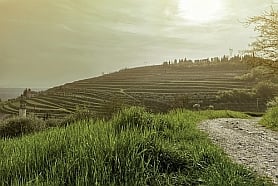Appassimento and ripasso are two euphonious terms that are now firmly established in the wine lover's lexicon. They refer to methods – one ancient and one modern – for concentrating and augmenting a wine's flavour. While the words are Italian, coined in the Veneto region, the concept of appassimento was first practised by the Greeks and then by the Romans, who would leave grape bunches to hang on the vine to allow them to desiccate, thereby concentrating their sugars.
This method of drying-on-the-vine worked very well in the sun-baked regions of southern Italy, but in the cool and rainy north, fruit left on the vine in the late fall was prone to developing mildew and rot. In these cooler regions, as a result, the Roman farmers harvested the grape bunches and took them indoors to allow them to dry on straw mats. This appassimento technique is still used today in the production of Amarone. Instead of straw mats, however, the grapes are either laid out on beds of bamboo cane or are strung up on wires in lofts to dry.
Amarone is a blend of three grapes: Corvina, Rondinella and Molinara. It's the dry version of its sweet cousin Recioto della Valpolicella, a wine that closely resembles the style consumed by the Romans at their banquets. (Roman hosts, incidentally, were not above adding a variety of substances to “enhance” their wine, substances such as tree resin, fenugreek – which must have made the wine taste like maple syrup – plaster and sea water.)
Valpolicella, the baby sister of Amarone, uses the same grape mix. The name Valpolicella derives from the Latin vallis pulicellae, which translates literally as “valley of the sand deposits” (although you will hear in the region another, albeit erroneous, explanation: that the place name comes from a Greek expression meaning “valley of many cellars.”) The wine of Vapolicella used to be a rather simple, light, dry red similar in style to Beaujolais — a wine you could lightly chill and serve with fish. But the application of ripasso changed all that.
The first Italian wine I ever purchased was the 1964 Masi Campofiorin, which was offered by the London Sunday Times Wine Club in 1966. I didn't know then that this wine was the first Valpolicella made by the ripasso method. Ripasso means “re-passed” and it refers to the process of pouring the young Valpolicella wine into barrels that contained the lees – the grape particles and dead yeast cells – of the Amarone production. The purpose of which was to enrich the wine.
Sandro Boscaini, the proprietor of the Masi group of wines, has been dubbed “Mister Amarone” for his work in developing the modern style of this wine. He also refined the concept of ripasso, a name he originally registered as a trademark but subsequently donated to the Verona Chamber of Commerce.
Today, you see the term on the front and back labels of a myriad of Veronese Valpolicella producers. In fact, in 2009 the practice was given a legal framework when it was given its own DOC designation, Ripasso della Valpolicella. Boscaini's improvement on the age-old process (of using the lees of Amarone production to beef up the aroma and flavour of Valpolicella) involved re-fermenting the wine by the addition of a small percentage of semi-dried grapes from the same varieties used for Amarone.
Some writers have suggested that, by drying grapes, you lose the sense of place where the vines were grown. But anyone who has tasted Masi's single vineyard Amarones will attest to the fact that Mazzano, Campolongo di Torbe and Vaio Armaron (a wine Masi makes and markets under the Serego Alighieri label) have readily recognizable terroir flavour differences. In fact, Sandro Boscaini contends that the drying process actually heightens the sense of terroir rather than diminishes it.
Ripasso as a winemaking technique is not confined to Veneto. Boscaini has opened a winery in Tupungato, Argentina, called Vigneti La Arboldea, where his technicians produce an air-dried Corvina that's blended with the local Malbec.
Nor is the method an exclusive preserve of the Veronese. In Canada, L'Acadie Vineyards in Nova Scotia, Ontario's Burning Kiln, Cave Spring Cellars, Colaneri, Cornerstone Estate, Pillitteri Estates Winery, Reif Estate and The Foreign Affair Winery have all made wines using air-dried grapes. So too do Intersection Winery, Castoro de Oro and Pentage in British Columbia.
The highest expression of these wines, however, is Veneto's Amarone. Twelve producers in that region have banded together as “Families of Q uality Amarone” to “safeguard the excellence of the Amarone product … and to promote the image of Amarone on an international level.” The members are as follows: Allegrini, Begali, Brigaldara, Masi Agricola, Musella, Speri, Tedeschi, Tenuta Sant'Antonio, Tommasi, Venturini and Zenato.
Amarone, because of its high alcohol content (Masi's single-vineyard Amarones clock in at a majestic 16.5 per cent) and the concentration of fruit and acidity, makes for a cellar-worthy wine that can last for three decades. They're the ideal partner for rich meat dishes, especially game and osso buco. My favourite dish: Risotto all'amarone(recipe at amaronetours.it/wines/amarone).
Tony Aspler is the author of 17 books on wine, including his latest, Canadian Wineries.





